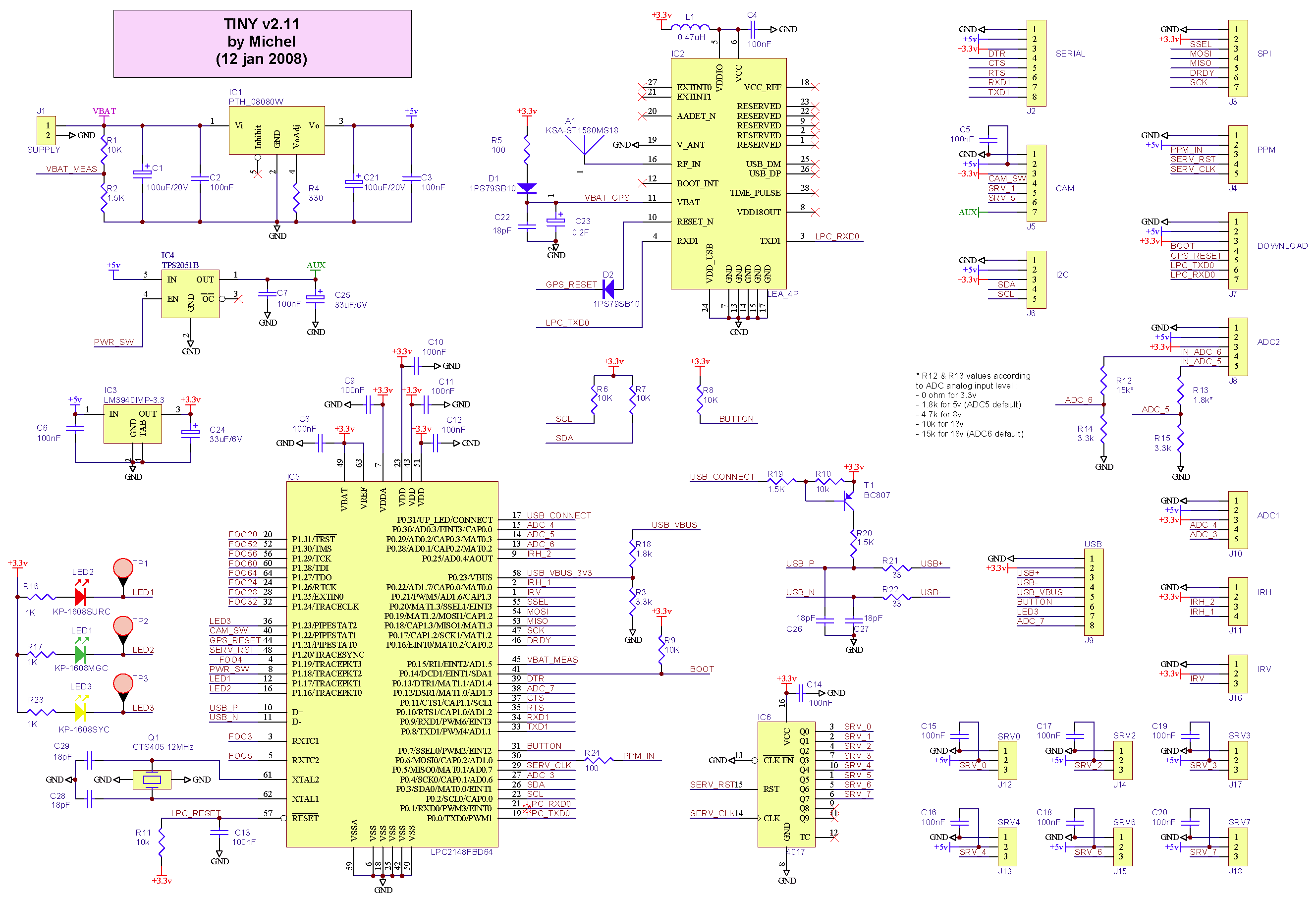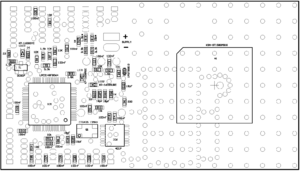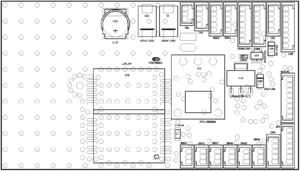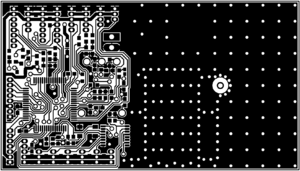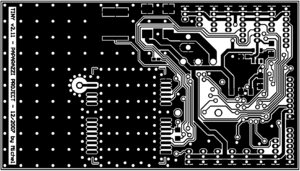Future Autopilots
Jump to navigation
Jump to search
Tiny 2.1, almost done!
The complete re-reouting of the Tiny autopilot was done on October 9, 2007. The new design is not a bug-fix as no known flaws exist with the current 0.99 and 1.1 versions, so the redesign is performance, easy to use and easy to assemble-oriented!
Feature additions
- Hardware flow control on the modem
- The LPC has one "full-featured" serial port and one basic serial port. Previous versions had the full-featured port hard-wired to the GPS in order to leave the basic port open for initial bootloader programming.
- Tiny 2.1 exchange these ports and use the GPS Reset signal to "disconnect" the GPS for the one-time bootloader programming.
- TI PTH08080WAH switching 5V/2.25A regulator
- This integrated power supply module greatly simplify manufacturing, reduce costs, and improve performance.
- Tiny 2.1 have a voltage input range of 6-16V and enough 5V power for large servos and high-power modems and video systems.
- 3.3V/1A linear regulator in a SOT223 standard pinout package.
- The new Tiny uses a 1A LDO linear regulator which is capable of providing plenty of power to modems or other devices but tests have shown that any device with irregular power consumption can cause significant voltage fluctuations on the critical 3.3V bus. Users are advised to use a separate regulator as needed for such devices. The new regulator will have at least 200mA available for peripherals to be used with caution.
- Video/payload power switch.
- The TPS1100 transistor used on the previous Tiny design has proven extremely useful but is intended for high-speed power switching of motor controllers and occupies a 5mm x 6mm space (SOIC-8). The replacement is a Ultra Low On-Resistance MosFet (165mOhms/2.6A) in small SOT23 package.
- Larger GPS ground plane and antenna
- The 13mm antenna on previous Tiny 1.1 proved to be an unworthy exchange of performance for weight. Crude parking-lot tests showed an approximate 3dBi loss (as expected from the data sheets), but the narrow bandwidth of the small antenna made it more sensitive to de-tuning from nearby components in the aircraft. Flight performance was acceptable but poor climb rate calculations were observed with the smaller antenna. Tiny 1.1 users are advised to fit a 20mm antenna.
- Tiny 2.1 use a 18mm x 4mm antenna (20mm x 4mm is possible but no more available) and feature 30% more ground plane area.
- GPS Reset connected to a GPIO pin on the MCU
- Occasionally the GPS fails to boot properly, displays very poor S/N ratios, and fails to obtain a valid fix. This may be caused by a slow power-up of the 5V or 3V regulators, or by some unusual EMI that is only present at boot. Usually a simple power cycle will correct the problem but occasionally the receiver seems to use the backup battery to retain the bad state. This feature allow the operator to reset the GPS as needed.
- Connector changes
- Tiny 2.1 feature revised header layouts on all peripherals.
- The modem header have CTS/RTS/DTR and both 5V and 3.3V supplies (3.3V is shared with LPC and ADC channels - use with caution and only with very low power modems like the 10mW Xbee).
- The button is removed and it's function is combined on the USB header along with an LED trigger so that indicator, button, and USB can be remotely mounted.
- New separate headers with their own supply :
- Vertical Infrared (1 ADC) with 3.3v supply
- Horizontal Infrared (2 ADC) with 3.3v supply
- 2 general purpose ADC with both 3.3v and 5v supplies
- 2 general purpose ADC with optional on-board 5v -> 3.3v resistor bridge and both 3.3v and 5v supplies
- Two axis Camera control with two servo signal, vdo switch control, vdo power switch and both 5V and 3.3V supplies
- SPI bus with 3.3V supply
- I2C bus with both 5V and 3V supplies
- 3 status LEDs with attached test point
- 0603 components
- Many users don't really think that using 0402 components is a great saving from any viewpoint. Even if one saves a little space by using these components, there must still be enough room around to solder it by hand with a soldering iron.
- With the Tiny 2.1, the assembly will be a bit more friendly to everyone, not only to the beginners.
- 2 Layers design
- Simplify manufacturing and reduce costs.
Download Tiny v2.1 complete design (pdf)
Proposed additions
We're always looking for great ideas. If you'd like to see something added or changed on Tiny 2.1 list it here! Please keep your suggestions relevant to this revision and post other requests in the Hardware Wish List.
- Separate GPS Option
- To provide more flexible airframe installation, EMI trouble resolution, and GPS hardware optimization, a second version of Tiny 2.1 will be created with no GPS receiver or antenna.
- (the only problem is to find a name for this new autopilot (Michel) :)
- EMI filters on ADC channels
- Analog sensors are severely affected by video and modem RF. We typically see ADC reading fluctuations of +/-0.5% in a well shielded installation, but a misbehaving video transmitter or a noisy Radiotronix modem can affect ADC channels by more than 50% in the same well shielded installation. The addition of effective filters to the ADC inputs should greatly reduce the effects of RFI and allow for a much broader range of RF equipment and airframe configurations.
- I suggest the On Semiconductor NUF4220MNT1G. A 2mm x 2mm chip that filters 4 analog signals, attenuatiing RF frequencies above 16 Mhz but particularly the 800 Mhz to 5 Ghz range. (Jeremy)
- NUF4220MN is a 4 line LC EMI filter array designed for audio applications. It offers greater than -30 dB attenuation at frequencies from 800 MHz to 5.0 GHz, with no line loss. This part is a single chip solution for audio interface applications, 2 speaker lines with a microphone line. This device also offers ESD protection-clamping transients from static discharges and ESD protection is provided across all capacitors.
- Decoupling capacitor on GPS antenna
- The u-blox reference design calls for a 47pF 10% 0603 capacitor in series between the receiver and antenna. I have no idea why this is useful but apparently it must be, because this technique is commonly seen on WiFi cards, video transmitters, modems, even R/C receivers. Maybe we're missing out on something great? (Jeremy)
- Power plug
- Most users agree that the 1.25mm Molex is inadequate for the 8-16V / 1-2A main power input. The obsolete Lite board used a 4-pin 1.25mm molex to address this issue but it was akward to connect two pairs of tiny 26AWG wire to the large main-power wires. Tiny 0.9 used a "Futaba/Hitec" style header for battery input - the idea was that you could simply modify your ESC moving the 5V wire over to the battery input terminal. This solution occupied a lot of space on the Tiny and the modified ESC could easily end up mistakenly connected to standard r/c equipment. Tiny 2.1 is currently slated to have large solder pads on the input capacitors that users can solder their own wires to. Please post suggestions for a "better" method, if one exists.
